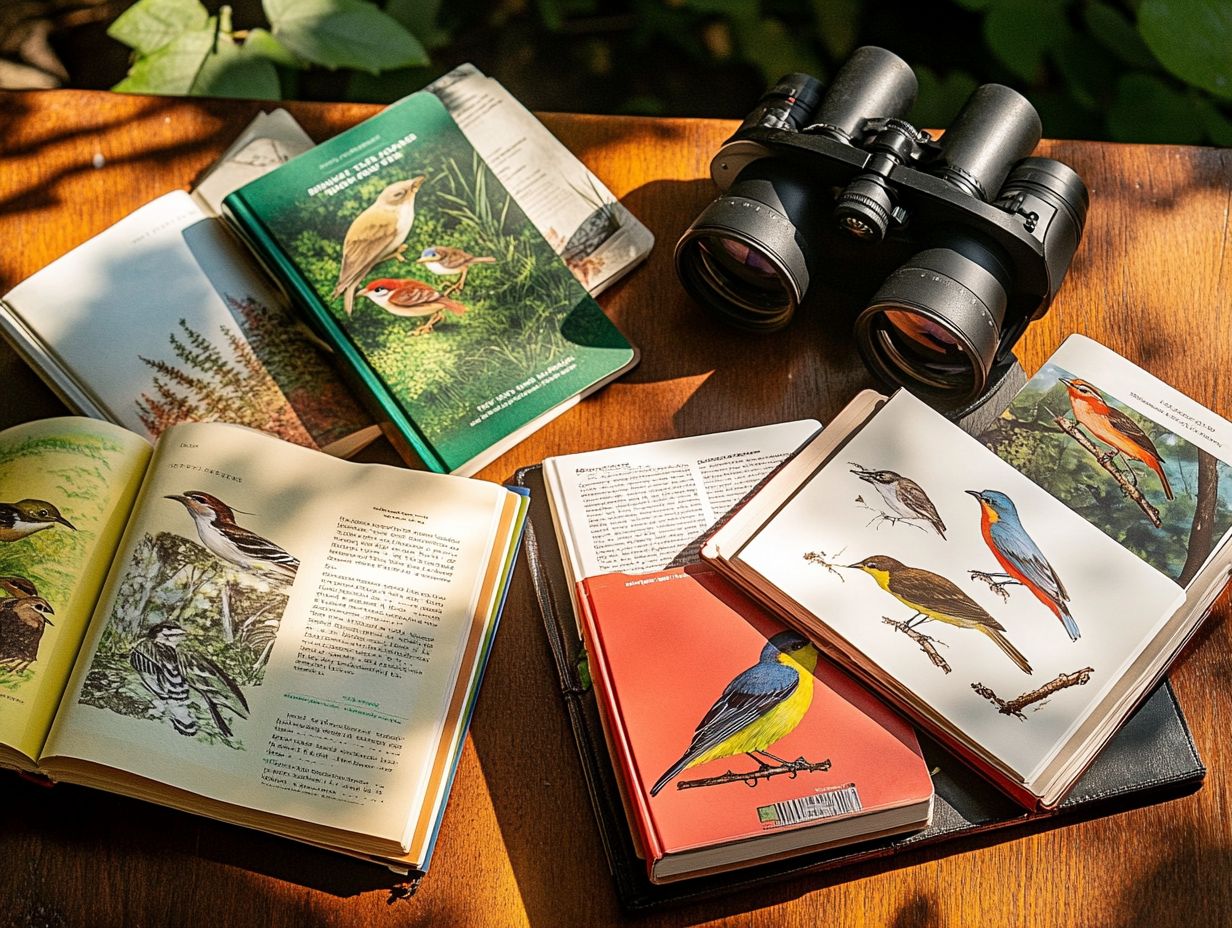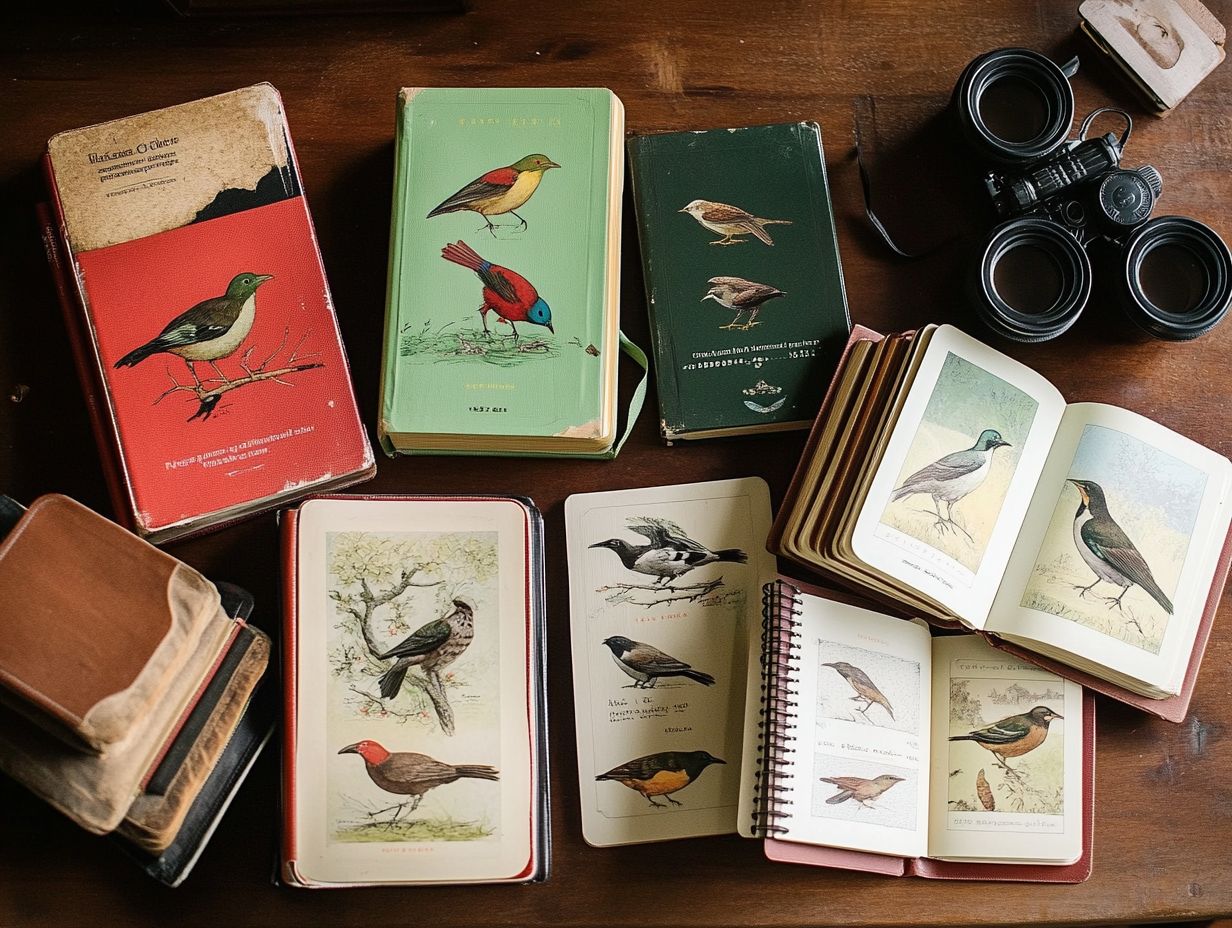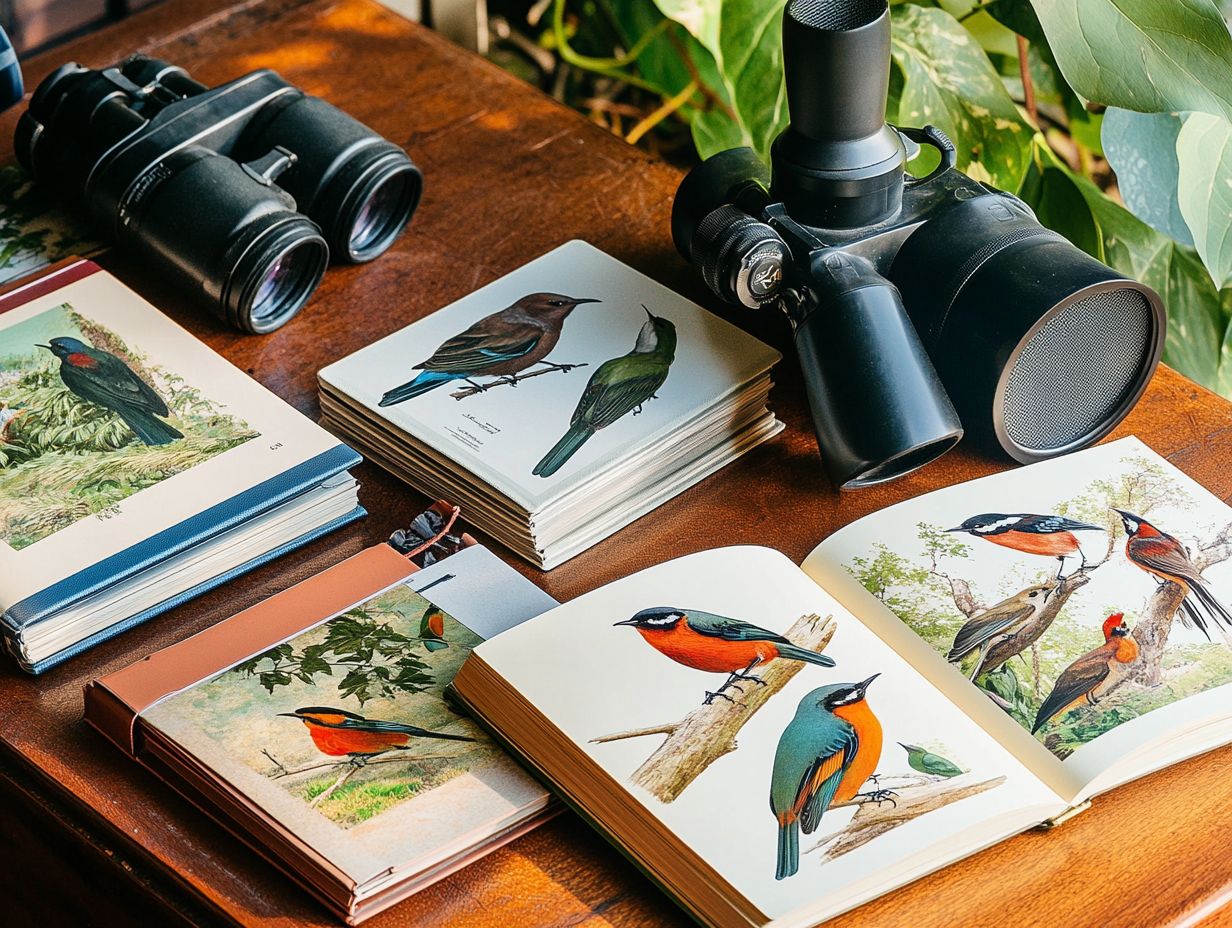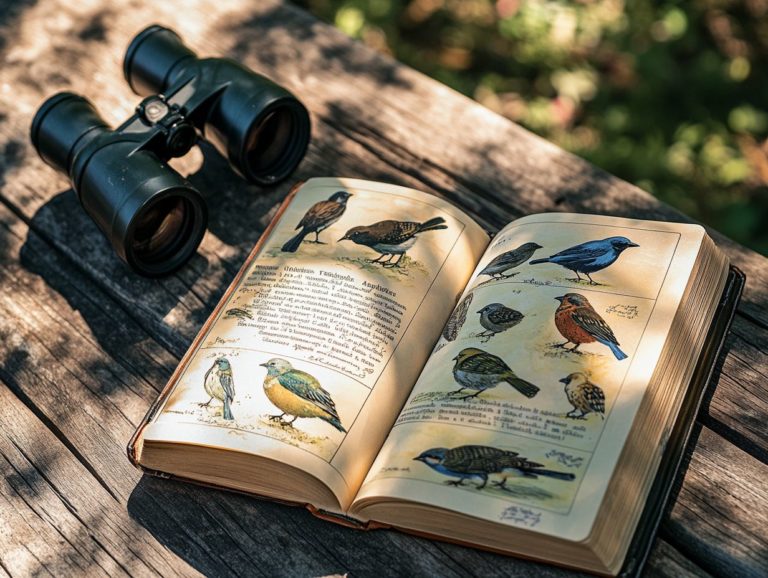The Most Comprehensive Bird Field Guides Available
Birdwatching is an enchanting hobby that invites you to immerse yourself in the beauty and diversity of avian life, making it a favorite among nature lovers.
Whether you re a seasoned ornithologist or just beginning to spread your wings, having the right field guides can elevate your birdwatching experience and refine your bird identification skills.
This article presents a carefully curated list of the most comprehensive bird field guides available, each offering unique features and insights tailored to your needs.
Explore what distinguishes these guides, discover the key characteristics of effective birding resources, including mobile apps and online resources, and see how they can deepen your appreciation for North America s feathered inhabitants.
Jump into and find the perfect companion for your birdwatching adventures!
Contents
- Key Takeaways:
- 1. The National Audubon Society Field Guide to North American Birds
- 2. The Sibley Guide to Birds
- 3. The Stokes Field Guide to Birds
- 4. The Peterson Field Guide to Birds
- 5. The Kaufman Field Guide to Birds of North America
- 6. The Crossley ID Guide: Eastern Birds
- 7. The Golden Guide to Birds of North America
- 8. The Smithsonian Field Guide to the Birds of North America
- 9. The Kaufman Field Guide to Advanced Birding
- 10. The National Geographic Field Guide to the Birds of North America
- 11. The Sibley Field Guide to Birds of Eastern North America
- 12. The Peterson Field Guide to Western Birds
- 13. The Stokes Beginner’s Guide to Birds
- 14. The Kaufman Field Guide to Nature of the Midwest
- 15. The National Wildlife Federation Field Guide to Birds of North America
- What Makes These Field Guides Stand Out?
- Frequently Asked Questions
- What are the most comprehensive bird field guides available?
- What sets these bird field guides apart from others?
- Are these bird field guides suitable for beginners?
- Can these bird field guides be used for birdwatching in different regions?
- Are these bird field guides regularly updated?
- Are these bird field guides available in digital formats?
Key Takeaways:

- Discover the National Audubon Society Field Guide to North American Birds, a comprehensive and popular guide with detailed illustrations and range maps.
- Uncover the Sibley Guide to Birds, known for its detailed artwork and thorough coverage of bird species in North America.
- Experience the Peterson Field Guide to Birds, which combines illustrations and photographs for easy identification of bird species and includes natural history information.
1. The National Audubon Society Field Guide to North American Birds
The National Audubon Society Field Guide to North American Birds is an essential resource tailored just for you, whether you’re a budding enthusiast or a seasoned birdwatcher. It offers a wealth of information on over 800 bird species native to North America, complete with stunning illustrations that enhance your bird identification experience.
This guide is well-organized, allowing you to swiftly access the information you need, whether you’re out in the field or comfortably at home. Its user-friendly format features detailed species descriptions, making it easier to identify various traits like plumage, behavior, and vocalizations. For those interested in exploring further, consider checking out the top bird field guides for international travel.
The Audubon Society and organizations like the National Geographic play a crucial role in promoting conservation awareness and education. Their efforts not only safeguard avian habitats but also deepen your appreciation for the natural world.
Within the broader context of birdwatching, this field guide is a vital companion, empowering you to engage with and advocate for bird conservation efforts. Get ready to elevate your birdwatching experience!
2. The Sibley Guide to Birds
The Sibley Guide to Birds stands as a premier field guide, celebrated for its detailed illustrations and comprehensive coverage of bird species. For those seeking more options, exploring the top field guides for coastal birding adventures can also be beneficial. It is a favorite for both beginners and seasoned birdwatchers, serving as an invaluable tool for bird identification and understanding bird behavior.
The guide features meticulous illustrations, crafted with precision rather than relying on photographs. This choice offers you a cleaner and more consistent representation of each species. While other guides may depend on images that can vary in quality, the uniform style of the Sibley Guide allows you to spot nuances in color and shape with ease important details for identifying birds.
Take, for example, its portrayal of the Black-throated Green Warbler, which highlights subtle plumage differences that can often bewilder even the most seasoned bird watchers. Users consistently praise how the guide enhances their experience with practical tips and notes on bird calls, habitats, and seasonal variations, making your journey into the avian world all the more enriching. Prepare to enhance your birdwatching journey!
3. The Stokes Field Guide to Birds
The Stokes Field Guide to Birds is a fantastic resource for birdwatchers, particularly those with an interest in backyard birds. It highlights the crucial role bird songs and calls play in the identification process.
This innovative guide includes sounds you can hear, like bird songs and calls, seamlessly connecting sounds to sights. Whether you’re a beginner embarking on your birdwatching journey or a seasoned enthusiast refining your skills, its compact design is perfect for easy portability.
The user-friendly layout not only facilitates quick identification but also enriches your overall birdwatching experience, deepening your appreciation for avian life and nurturing a harmonious connection with nature.
4. The Peterson Field Guide to Birds
The Peterson Field Guide to Birds stands as an essential guide, renowned for its easy-to-understand features that simplify the identification process for birdwatchers like you.
Its striking illustrations and concise descriptions give you the power to distinguish between similar-looking species, such as the vivid contrast between the male and female cardinal, each beautifully depicted in the guide. The inclusion of regional guides allows you to focus on birds specific to your area, enriching your learning journey.
This guide highlights key features like:
- Plumage patterns
- Beak shapes
- Vocalizations
Making it an invaluable asset, whether you re a novice or an experienced birder. These features not only facilitate swift identification but also enhance your appreciation for local biodiversity, fostering a deeper connection with the natural world around you.
5. The Kaufman Field Guide to Birds of North America
Get ready to immerse yourself in the world of birds! The Kaufman Field Guide to Birds of North America truly stands out with its engaging visual aids and user-friendly layout, perfectly catering to both novice birders and seasoned birdwatchers alike in the North American birding community, enhancing the overall birdwatching experience.
This guide stands out due to its thoughtful design, featuring detailed illustrations that allow you to quickly distinguish between species even in less-than-ideal viewing conditions. The significance of visual aids can’t be overstated; they are essential tools in your identification journey, making learning both effective and enjoyable.
As a novice, you’ll find the insights on selecting the right gear, including binoculars and field notes, incredibly valuable. The guide addresses common queries about binoculars and field notes, ensuring you feel confident and equipped to embark on your birding adventures.
6. The Crossley ID Guide: Eastern Birds
The Crossley ID Guide: Eastern Birds transforms the conventional bird guide experience through its innovative approach, featuring realistic illustrations and engaging layouts that make bird identification not only intuitive but also a visual delight for you as a birdwatcher, especially when observing oceanic birds in their habitats.
Unlike traditional guides that rely primarily on photographs, this exceptional resource immerses you in the natural habitats of various bird species. It illustrates not just their appearances but also how they interact within their environments.
The dynamic portrayals of multiple birds in interactive settings provide a richer understanding of behaviors, such as feeding, nesting, and migration patterns. This approach enhances your learning experience, giving you the power to differentiate between species more effectively as you appreciate the context in which these birds thrive.
Ultimately, the Crossley ID Guide enables both novice and seasoned birdwatchers like you to foster a deeper connection with avian life.
7. The Golden Guide to Birds of North America

The Golden Guide to Birds of North America is your ultimate resource filled with essential birding tips and invaluable information on a wide range of bird species. It’s tailored perfectly for outdoor adventurers and nature enthusiasts like you.
This cherished guide doesn t just enhance your birdwatching experience. It also holds a significant place in the study of birds. By breaking down complex information into easily digestible formats, it gives you the power whether you’re just starting out or you’re a seasoned expert to identify North American birds with confidence.
You’ll find practical advice that spans everything from selecting the right binoculars to understanding birds’ behaviors. This makes it an essential companion for your hikes through lush forests or leisurely walks along sunlit shores.
Ultimately, the Golden Guide helps you dive into the vibrant bird world and nurtures a deeper appreciation for the wonders of nature.
8. The Smithsonian Field Guide to the Birds of North America
The Smithsonian Field Guide to the Birds of North America is your ultimate reference for birdwatching. It places a strong emphasis on bird identification through insightful explanations of their habitats, behaviors, and ecological facts.
This guide stands out by offering a vast collection of species profiles and valuable insights into their behaviors and interactions with the environment, including bird songs and calls. For a deeper understanding, consider exploring understanding bird behavior with field guides. You’ll appreciate the depth of information that transcends simple identification, allowing you to grasp the ecological significance of various birds across North America.
Whether you consider yourself a seasoned bird expert or a casual observer, the readability and rich illustrations create an engaging learning experience. It encourages exploration and deepens your appreciation for avian life.
9. The Kaufman Field Guide to Advanced Birding
The Kaufman Field Guide to Advanced Birding is designed specifically for you, the seasoned birdwatcher. It provides in-depth techniques for bird identification and insights into tricky species like raptors, which are birds of prey, and shorebirds, found along coastlines.
As you explore these advanced methodologies, you’ll find your observational skills sharpened. This allows you to navigate the complexities of avian behavior with ease. This guide invites you to develop a deeper appreciation for the intricate details of plumage variations, vocalizations, and migratory patterns that often go unnoticed.
With expert tips on tracking elusive birds across diverse habitats, this resource is essential for anyone wanting to take their birdwatching to the next level. Whether you re trekking through remote wilderness or enjoying local parks, this guide will be your trusted companion on your journey to expanding your avian knowledge.
10. The National Geographic Field Guide to the Birds of North America
The National Geographic Field Guide to the Birds of North America is your go-to companion. For even more insights, check out the most recommended field guides by experts, which blend stunning visuals with precise species descriptions to elevate your bird identification journey.
Its well-organized layout and crystal-clear photographs not only draw you in but also make navigation a breeze. This guide ensures that whether you re a seasoned birdwatcher or just starting to explore this fascinating hobby, you have essential information at your fingertips.
The detailed maps and insightful tips enhance your birdwatching experience. They allow you to spot and appreciate subtle differences between closely related species. This deeper understanding enriches your connection to the natural world, making each outing an opportunity for discovery and delight.
11. The Sibley Field Guide to Birds of Eastern North America
The Sibley Field Guide to Birds of Eastern North America is a great resource that offers detailed pictures and in-depth insights into bird behavior, making bird identification in the eastern regions a breeze. This guide, like the Crossley ID Guide, emphasizes visual aids for easier identification.
What sets this guide apart is its depth and tailored approach to the diverse avian life found in the East. Each meticulously crafted illustration acts as a visual aid, helping you distinguish between species that may appear similar at first glance, enhancing your understanding of bird identification with field guides.
By highlighting subtle differences in feather colors and patterns and physical characteristics, the guide gives you the power to refine your skills, whether you re a beginner or an experienced birdwatcher. The engaging commentary on bird behavior enriches your understanding, making this guide an essential companion for anyone captivated by the rich avifauna of Eastern North America.
12. The Peterson Field Guide to Western Birds
The Peterson Field Guide to Western Birds is an essential resource for you as you explore the rich tapestry of avian life in the western regions. It equips you with essential bird identification techniques that focus on field marks (features that help identify birds), crucial for differentiating among species.
The Peterson Guide stands apart by spotlighting easily recognizable features like color patterns, size, and behaviors. These field marks become your trusted allies, giving you the power to confidently distinguish between closely related species.
Unlike other guidebooks that might lean heavily on vague descriptions, the Peterson approach distills identifying characteristics into clear visual cues. This practical focus not only elevates your learning experience but also deepens your connection with the natural world. As you observe, you’ll begin to appreciate the subtle variations and unique traits that make each bird species truly remarkable.
13. The Stokes Beginner’s Guide to Birds
The Stokes Beginner’s Guide to Birds serves as an ideal launching pad for novice birdwatchers, brimming with practical tips and a keen focus on common backyard birds that gently introduce you to the enchanting world of birdwatching. This guide is essential for nature lovers hoping to engage with avian life!
With clear illustrations and detailed descriptions, this guide enables you to swiftly identify local species, a vital step in cultivating a deeper appreciation for avian life. It emphasizes the virtues of patience and keen observation, inspiring you to spend quality time in your backyard or local parks.
You ll find straightforward methods for attracting birds, understanding their behavior, and recording your sightings, ensuring that each outing is as enjoyable as it is educational. This resource is crafted to make birdwatching not only accessible but also genuinely rewarding for everyone, no matter your level of expertise.
14. The Kaufman Field Guide to Nature of the Midwest

The Kaufman Field Guide to the Nature of the Midwest intricately weaves together the region’s bird species with their specific habitats, providing you with essential insights for your birding adventures. This guide is a pivotal resource for birdwatchers eager to explore the Midwest.
By exploring the diverse ecosystems of the Midwest, this guide becomes invaluable for understanding not only where to find various species but also how seasonal changes and local flora affect bird behavior and migration patterns.
The knowledge you gain from this integrated approach can significantly enhance your birdwatching experience, enabling both beginners and experienced observers to appreciate the delicate balance between wildlife and their environments.
Recognizing the nuances of different habitats will deepen your connection to nature, allowing you to locate and identify local species more effectively while also championing conservation efforts in your community.
15. The National Wildlife Federation Field Guide to Birds of North America
The National Wildlife Federation Field Guide to Birds of North America equips you with essential information on bird species and identification. This makes it a must-have resource for birdwatchers and nature enthusiasts alike.
This guide offers detailed descriptions of various bird species. It covers their habitats, behaviors, and unique traits. Additionally, it highlights the critical role each species plays in its ecosystem.
Its user-friendly layout, adorned with vibrant illustrations and well-organized entries, streamlines the identification process. This encourages you to immerse yourself more fully in your outdoor adventures.
By deepening your understanding of bird life, this guide helps protect birds and their homes. Ultimately, it fuels educational initiatives, inspiring you and future generations of bird lovers to cherish and advocate for wildlife preservation and the use of outdoor adventure.
What Makes These Field Guides Stand Out?
Field guides are essential for birdwatchers. They help you identify birds and enhance your experience, especially when comparing various guide comparisons.
You ll notice that different guides can vary quite a bit in their design. Some prioritize meticulous illustrations that capture every nuance of a bird’s plumage and behavior, while others lean toward stunning photographs that provide a realistic glimpse of species in their natural habitats.
If you re a seasoned birdwatcher, you might appreciate guides that include extra tools like range maps and vocalization descriptions. Conversely, if you re just starting out, simplified layouts focusing on common species will likely serve you better.
This careful selection helps every birdwatcher, no matter their skill level, find a guide that resonates with their learning style and enhances their enjoyment of this captivating hobby.
How Do These Guides Differ from Each Other?
Each bird field guide offers a unique take on bird identification techniques. To enhance your experience, consider checking out the top 10 field guides for North American birds, which showcase variations in guide formats, visual aids, and content tailored to your birdwatching preferences.
For instance, you might find some guides packed with stunning photographs that draw in casual observers, while others may feature intricate illustrations designed to captivate more experienced enthusiasts.
Your target audience plays a significant role in shaping these approaches. Beginner-friendly guides typically present simplified information and quick-reference charts to facilitate swift identification.
Advanced guides dive deeply into behavioral habits and ecological contexts, offering invaluable insights for seasoned birdwatchers, including birding tips for maximizing your experience.
The guides also include audio of bird calls and songs, catering to your diverse proficiency levels. This helps both novices and veterans refine their skills, no matter where they begin their journey in the birdwatching community.
What Are the Key Features of a Good Bird Field Guide?
A good bird field guide should be your trusted companion, packed with essential features like comprehensive species descriptions, effective pictures and drawings, and clear identification techniques that elevate your birdwatching experience to new heights.
By offering detailed descriptions that delve into habitat preferences, behaviors, and vocalizations, this guide will open your eyes to the amazing world of birds!
Pictures and drawings become invaluable tools, enabling you to swiftly recognize different species while out in the field.
Clear identification techniques, including key markings and size comparisons, simplify the art of distinguishing between similar-looking birds. This ensures you don t miss out on any fascinating finds.
For instance, guides that incorporate range maps allow you to identify where specific species are likely to be spotted. This transforms every outing into a more productive and enriching adventure.
How Can These Guides Help with Bird Identification?
Bird field guides are invaluable tools for birdwatchers, packed with identification techniques, field marks, and detailed descriptions that empower you to recognize various bird species with confidence! For those looking to enhance their experience, check out the top 10 bird guides available online.
These guides highlight features like color patterns, size comparisons, and unique markings. This makes it easier to differentiate between similar-looking species. For instance, distinctive wing bars, eye patches, or tail shapes provide crucial clues in both woodland and wetland environments.
Whether you re marveling at the brilliant plumage of a warbler flitting through a sunlit forest or observing the subtle hues of a shorebird along the coast, the right field guide can elevate your birdwatching experience. Understanding the habitat preferences of different species based on their physical characteristics sets you up for more successful sightings in the field.
What Are the Benefits of Using a Field Guide for Birding?
Using a field guide for birding offers many advantages. It enhances your bird identification skills, deepens your understanding of bird behavior, and connects you with the vibrant birdwatching community. This enriches your outdoor adventures and makes the experience truly fulfilling.
A field guide provides essential insights into species habitats and migration patterns. This fosters a shared appreciation for the variety of bird species among enthusiasts like you. Engaging with these guides can spark your advocacy for their natural habitats.
Educational initiatives can inspire you to get involved in community projects, helping to create an environment that values wildlife preservation. Using a field guide transforms casual observation into an informed and passionate practice that supports your personal growth while championing broader environmental stewardship.
Frequently Asked Questions

What are the most comprehensive bird field guides available?
The most comprehensive bird field guides include “The Sibley Guide to Birds” by David Allen Sibley, known for its beautiful illustrations and comprehensive species coverage, “National Geographic Field Guide to the Birds of North America” by Jon L. Dunn and Jonathan Alderfer, which is favored for its detailed descriptions, and “The Kaufman Field Guide to Birds of North America” by Kenn Kaufman, appreciated for its user-friendly layout. If you’re looking to enhance your birdwatching experience, consider the top features to look for in a bird field guide.
What sets these bird field guides apart from others?
These guides stand out due to their extensive coverage of bird species, detailed illustrations and descriptions, and thorough information on bird behavior and identification tips.
Are these bird field guides suitable for beginners?
Yes! These guides are user-friendly and provide helpful tips for bird identification. They also include maps and range information for each species, making it easier for beginners to locate and identify birds in their area. They ll help you spot your first bird in no time!
Can these bird field guides be used for birdwatching in different regions?
Yes! These guides cover a wide range of bird species found in North America, making them useful for birdwatching in various regions. However, for specific areas, it is best to use a field guide that focuses on that region.
Are these bird field guides regularly updated?
Yes, these guides are regularly updated to include new species and updated information on existing species. It is advisable to check for the most recent edition when purchasing a bird field guide.
Are these bird field guides available in digital formats?
Yes! These guides are available in digital formats, such as e-books and apps, making them convenient for field use. However, some birdwatchers prefer using physical copies for easier reference and note-taking.






